coolant YAMAHA YZ450F 2012 Owners Manual
[x] Cancel search | Manufacturer: YAMAHA, Model Year: 2012, Model line: YZ450F, Model: YAMAHA YZ450F 2012Pages: 228, PDF Size: 11.42 MB
Page 15 of 228
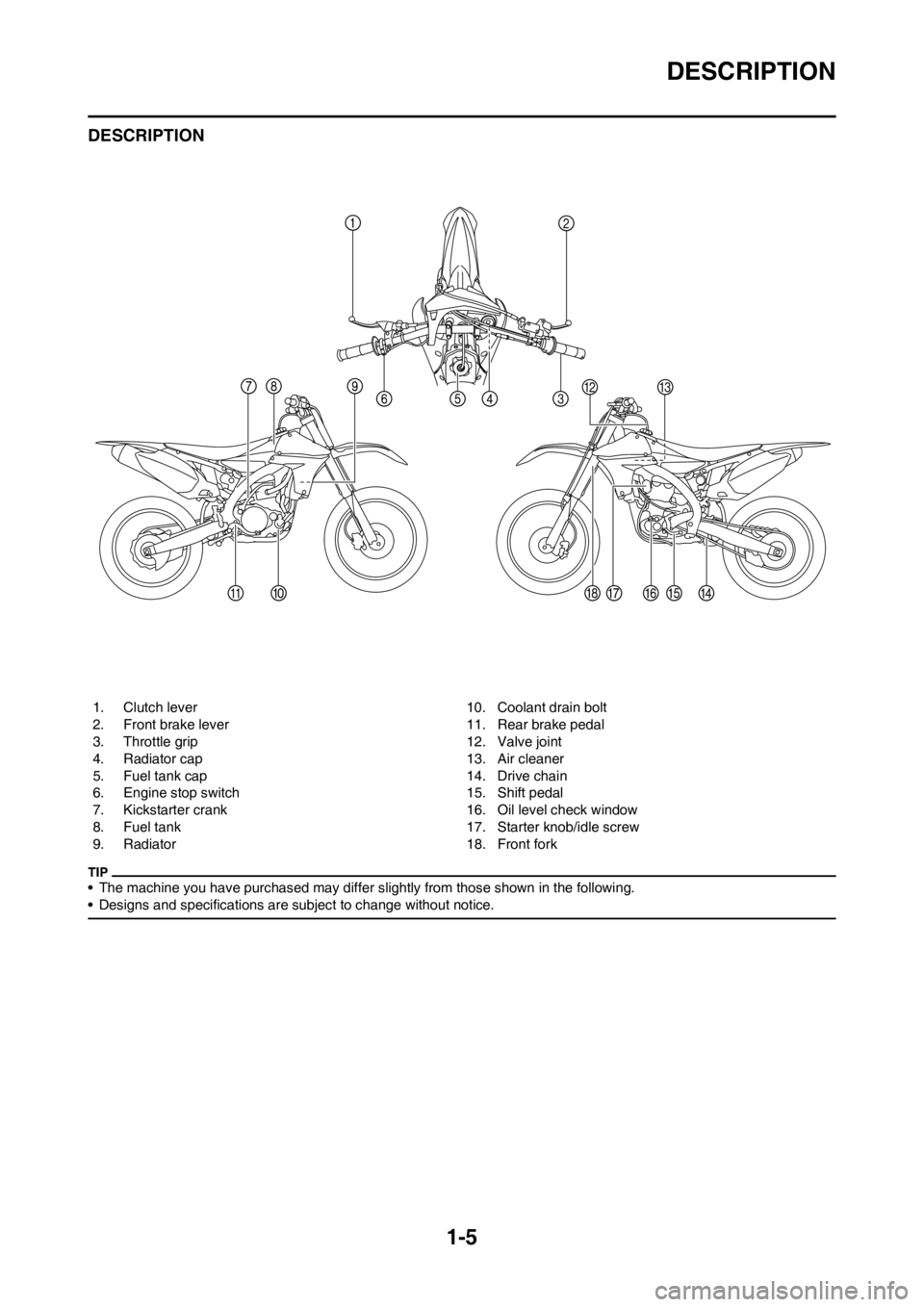
1-5
DESCRIPTION
DESCRIPTION
• The machine you have purchased may differ slightly from those shown in the following.
• Designs and specifications are subject to change without notice.
1. Clutch lever
2. Front brake lever
3. Throttle grip
4. Radiator cap
5. Fuel tank cap
6. Engine stop switch
7. Kickstarter crank
8. Fuel tank
9. Radiator10. Coolant drain bolt
11. Rear brake pedal
12. Valve joint
13. Air cleaner
14. Drive chain
15. Shift pedal
16. Oil level check window
17. Starter knob/idle screw
18. Front fork
Page 17 of 228

1-7
FEATURES
FEATURES
OUTLINE OF THE FI SYSTEM
The main function of a fuel supply system is to provide fuel to the combustion chamber at the optimum air-fuel ratio in ac-
cordance with the engine operating conditions and the atmospheric temperature. In the conventional carburetor system,
the air-fuel ratio of the mixture that is supplied to the combustionchamber is created by the volume of the intake air and the
fuel that is metered by the jet used in the respective carburetor.
Despite the same volume of intake air, the fuel volume requirement varies by the engine operating conditions,such as ac-
celeration, deceleration, or operating under a heavy load. Carburetors that meter thefuel through the use of jets have been
provided with various auxiliary devices, so that an optimum air-fuel ratio can be achieved to accommodate the constant
changes in the operating conditions of the engine.
This model has adopted an electronically controlled fuel injection (FI) system, in place of the conventional carburetor sys-
tem. This system can achieve an optimum air-fuel ratio required bythe engine at all times by using a microprocessor that
regulates the fuel injection volume according tothe engine operating conditions detected by various sensors.
1. Fuel injector
2. Throttle position sensor
3. Intake air pressure sensor
4. ECU
5. Fuel pump
6. Intake air temperature sensor7. Atmospheric pressure sensor
8. Crankshaft position sensor
9. Coolant temperature sensor
10. Ignition coil
11. Condenser
Page 18 of 228
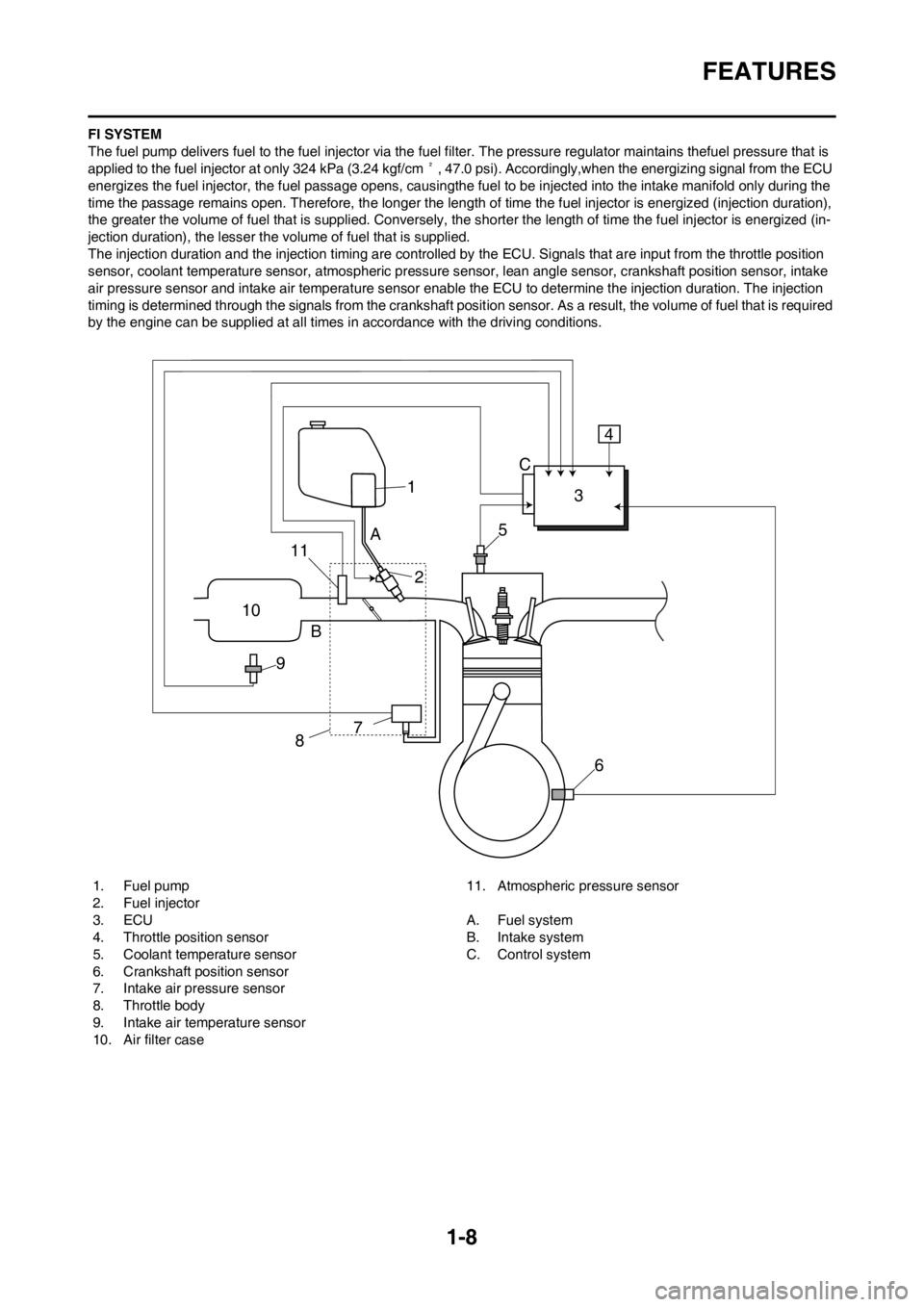
1-8
FEATURES
FI SYSTEM
The fuel pump delivers fuel to the fuel injector via the fuel filter. The pressure regulator maintains thefuel pressure that is
applied to the fuel injector at only 324 kPa (3.24 kgf/cm², 47.0 psi). Accordingly,when the energizing signal from the ECU
energizes the fuel injector, the fuel passage opens, causingthe fuel to be injected into the intake manifold only during the
time the passage remains open. Therefore, the longer the length of time the fuel injector is energized (injection duration),
the greater the volume of fuel that is supplied. Conversely, the shorter the length of time the fuel injector is energized (in-
jection duration), the lesser the volume of fuel that is supplied.
The injection duration and the injection timing are controlled by the ECU. Signals that are input from the throttle position
sensor, coolant temperature sensor, atmospheric pressure sensor, lean angle sensor, crankshaft position sensor, intake
air pressure sensor and intake air temperature sensor enable the ECU to determine the injection duration. The injection
timing is determined through the signals from the crankshaft position sensor. As a result, the volume of fuel that is required
by the engine can be supplied at all times in accordance with the driving conditions.
1. Fuel pump
2. Fuel injector
3. ECU
4. Throttle position sensor
5. Coolant temperature sensor
6. Crankshaft position sensor
7. Intake air pressure sensor
8. Throttle body
9. Intake air temperature sensor
10. Air filter case11. Atmospheric pressure sensor
A. Fuel system
B. Intake system
C. Control system
1
10
9B
87
6 5
A
23 C4
11
Page 28 of 228
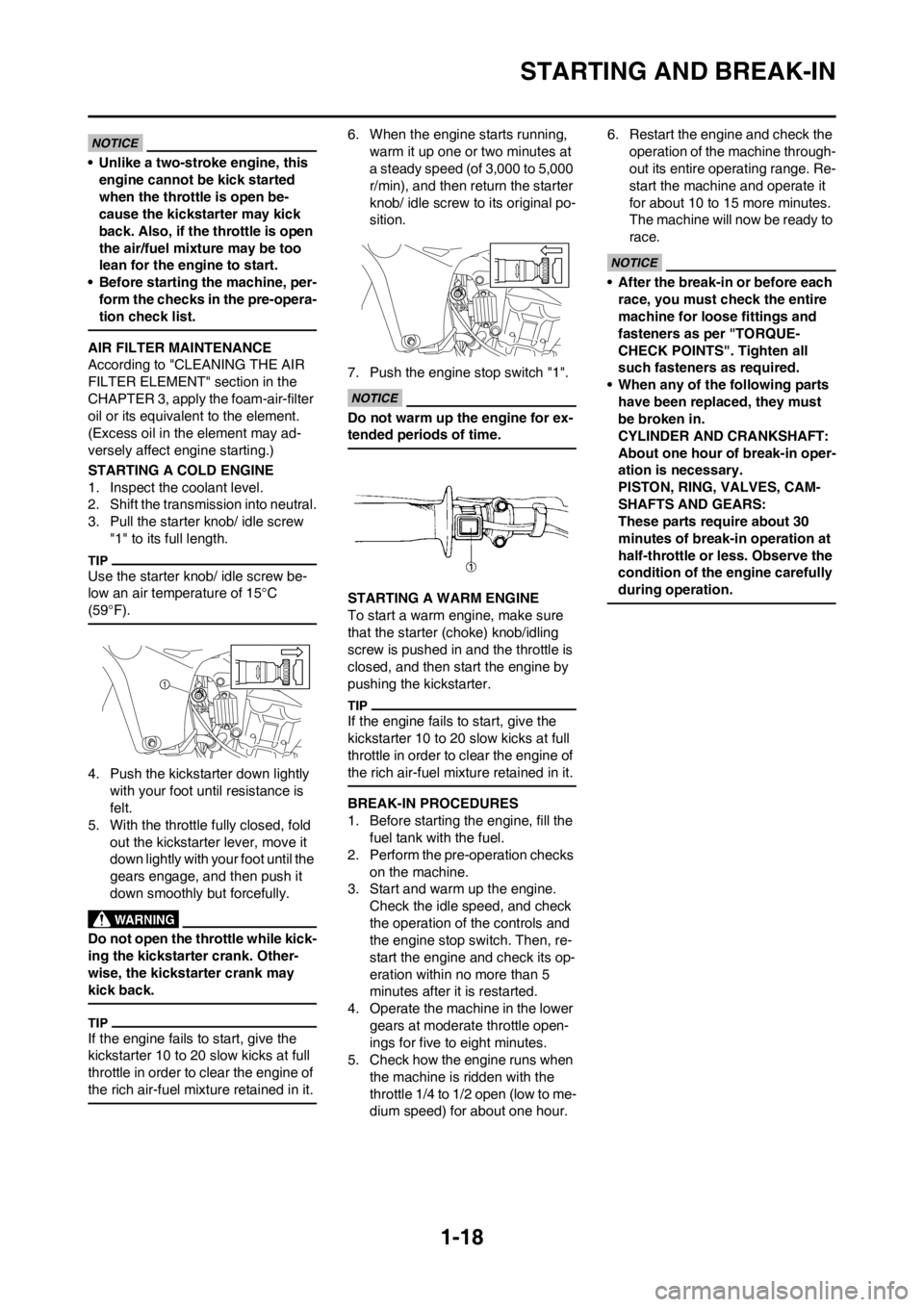
1-18
STARTING AND BREAK-IN
• Unlike a two-stroke engine, this
engine cannot be kick started
when the throttle is open be-
cause the kickstarter may kick
back. Also, if the throttle is open
the air/fuel mixture may be too
lean for the engine to start.
• Before starting the machine, per-
form the checks in the pre-opera-
tion check list.
AIR FILTER MAINTENANCE
According to "CLEANING THE AIR
FILTER ELEMENT" section in the
CHAPTER 3, apply the foam-air-filter
oil or its equivalent to the element.
(Excess oil in the element may ad-
versely affect engine starting.)
STARTING A COLD ENGINE
1. Inspect the coolant level.
2. Shift the transmission into neutral.
3. Pull the starter knob/ idle screw
"1" to its full length.
Use the starter knob/ idle screw be-
low an air temperature of 15°C
(59°F).
4. Push the kickstarter down lightly
with your foot until resistance is
felt.
5. With the throttle fully closed, fold
out the kickstarter lever, move it
down lightly with your foot until the
gears engage, and then push it
down smoothly but forcefully.
Do not open the throttle while kick-
ing the kickstarter crank. Other-
wise, the kickstarter crank may
kick back.
If the engine fails to start, give the
kickstarter 10 to 20 slow kicks at full
throttle in order to clear the engine of
the rich air-fuel mixture retained in it.
6. When the engine starts running,
warm it up one or two minutes at
a steady speed (of 3,000 to 5,000
r/min), and then return the starter
knob/ idle screw to its original po-
sition.
7. Push the engine stop switch "1".
Do not warm up the engine for ex-
tended periods of time.
STARTING A WARM ENGINE
To start a warm engine, make sure
that the starter (choke) knob/idling
screw is pushed in and the throttle is
closed, and then start the engine by
pushing the kickstarter.
If the engine fails to start, give the
kickstarter 10 to 20 slow kicks at full
throttle in order to clear the engine of
the rich air-fuel mixture retained in it.
BREAK-IN PROCEDURES
1. Before starting the engine, fill the
fuel tank with the fuel.
2. Perform the pre-operation checks
on the machine.
3. Start and warm up the engine.
Check the idle speed, and check
the operation of the controls and
the engine stop switch. Then, re-
start the engine and check its op-
eration within no more than 5
minutes after it is restarted.
4. Operate the machine in the lower
gears at moderate throttle open-
ings for five to eight minutes.
5. Check how the engine runs when
the machine is ridden with the
throttle 1/4 to 1/2 open (low to me-
dium speed) for about one hour.6. Restart the engine and check the
operation of the machine through-
out its entire operating range. Re-
start the machine and operate it
for about 10 to 15 more minutes.
The machine will now be ready to
race.
• After the break-in or before each
race, you must check the entire
machine for loose fittings and
fasteners as per "TORQUE-
CHECK POINTS". Tighten all
such fasteners as required.
• When any of the following parts
have been replaced, they must
be broken in.
CYLINDER AND CRANKSHAFT:
About one hour of break-in oper-
ation is necessary.
PISTON, RING, VALVES, CAM-
SHAFTS AND GEARS:
These parts require about 30
minutes of break-in operation at
half-throttle or less. Observe the
condition of the engine carefully
during operation.
Page 31 of 228
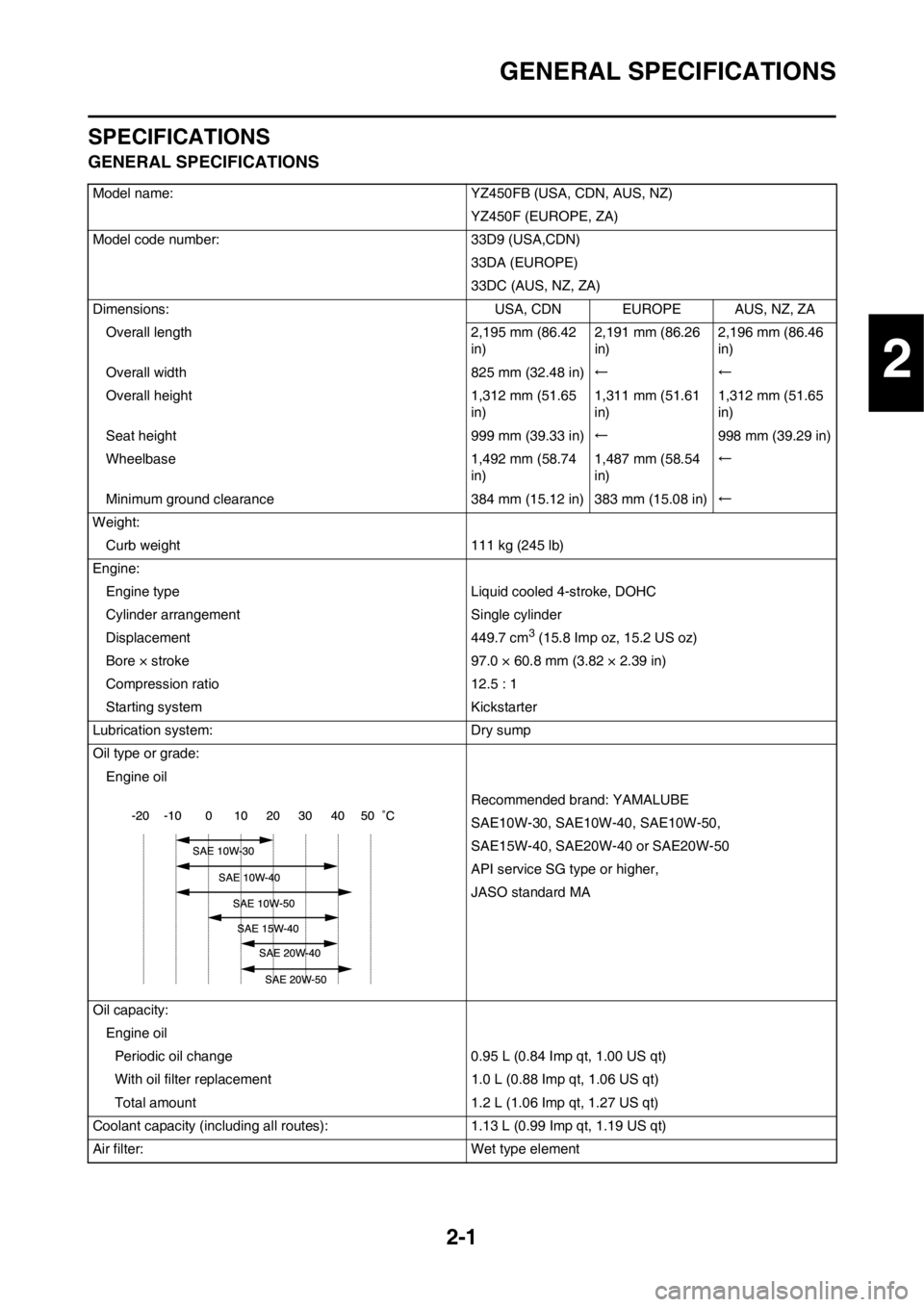
2-1
GENERAL SPECIFICATIONS
SPECIFICATIONS
GENERAL SPECIFICATIONS
Model name: YZ450FB (USA, CDN, AUS, NZ)
YZ450F (EUROPE, ZA)
Model code number: 33D9 (USA,CDN)
33DA (EUROPE)
33DC (AUS, NZ, ZA)
Dimensions: USA, CDN EUROPE AUS, NZ, ZA
Overall length 2,195 mm (86.42
in)2,191 mm (86.26
in)2,196 mm (86.46
in)
Overall width 825 mm (32.48 in)←←
Overall height 1,312 mm (51.65
in)1,311 mm (51.61
in)1,312 mm (51.65
in)
Seat height 999 mm (39.33 in)←998 mm (39.29 in)
Wheelbase 1,492 mm (58.74
in)1,487 mm (58.54
in)←
Minimum ground clearance 384 mm (15.12 in) 383 mm (15.08 in)←
Weight:
Curb weight 111 kg (245 lb)
Engine:
Engine type Liquid cooled 4-stroke, DOHC
Cylinder arrangement Single cylinder
Displacement 449.7 cm
3 (15.8 Imp oz, 15.2 US oz)
Bore × stroke 97.0 × 60.8 mm (3.82 × 2.39 in)
Compression ratio 12.5 : 1
Starting system Kickstarter
Lubrication system: Dry sump
Oil type or grade:
Engine oil
Recommended brand: YAMALUBE
SAE10W-30, SAE10W-40, SAE10W-50,
SAE15W-40, SAE20W-40 or SAE20W-50
API service SG type or higher,
JASO standard MA
Oil capacity:
Engine oil
Periodic oil change 0.95 L (0.84 Imp qt, 1.00 US qt)
With oil filter replacement 1.0 L (0.88 Imp qt, 1.06 US qt)
Total amount 1.2 L (1.06 Imp qt, 1.27 US qt)
Coolant capacity (including all routes): 1.13 L (0.99 Imp qt, 1.19 US qt)
Air filter: Wet type element
2
Page 40 of 228

2-10
MAINTENANCE SPECIFICATIONS
ELECTRICALFront disc brake:
Disc outside dia.×Thickness 250 × 3.0 mm (9.84 × 0.12 in) 250 × 2.5 mm
(9.84 × 0.10 in)
Pad thickness 4.4 mm (0.17 in) 1.0 mm (0.04
in)
Master cylinder inside dia. 9.52 mm (0.375 in) ----
Caliper cylinder inside dia. 22.65 mm (0.892 in) × 2 ----
Brake fluid type DOT #4 ----
Rear disc brake:
Disc outside dia.×Thickness 245 × 4.0 mm (9.65 × 0.16 in) 245 × 3.5 mm
(9.65 × 0.14 in)
Deflection limit ---- 0.15 mm
(0.006 in)
Pad thickness 6.4 mm (0.25 in) 1.0 mm (0.04
in)
Master cylinder inside dia. 11.0 mm (0.433 in) ----
Caliper cylinder inside dia. 25.4 mm (1.000 in) × 1 ----
Brake fluid type DOT #4 ----
Brake lever and brake pedal:
Brake lever position 95 mm (3.74 in) ----
Brake pedal height (vertical height above footrest
top)Zero mm (Zero in) ----
Clutch lever free play (lever end) 7–12 mm (0.28–0.47 in) ----
Throttle grip free play3–5 mm (0.12–0.20 in) ---- Item Standard Limit
Item Standard Limit
Ignition system:
Advancer type Electrical ----
AC magneto:
Magneto-model (stator)/manufacturer 33D00/YAMAHA ----
Stator coil resistance (color) 0.60–0.90 Ωat 20 °C (68 °F)
(White–White)----
Crankshaft position sensor resistance (color) 248–372 Ωat 20 °C (68 °F) (Gray–Black) ----
ECU-model/manufacturer 33D7 (USA, CDN) ----
33D4 (EUROPE) ----
33D6 (AUS, NZ, ZA) ----
Ignition coil:
Model/manufacturer F6T541/MITSUBISHI ----
Minimum spark gap 6 mm (0.24 in) ----
Primary coil resistance 3.57–4.83 Ωat 20 °C (68 °F) ----
Secondary coil resistance 10.71–14.49 kΩat 20 °C (68 °F) ----
Coolant temperature sensor:
Coolant temperature sensor resistance 2.51–2.78 kΩat 20 °C (68 °F) ----
210–220 kΩat 100 °C (212 °F) ----
Page 41 of 228

2-11
TIGHTENING TORQUES
TIGHTENING TORQUES
ENGINE
△- marked portion shall be checked for torque tightening after break-in or before each race.
ItemThread
sizeQ'ty Tightening torque Remarks
Spark plug M10S 1 13 Nm (1.3 m•kg, 9.4 ft•lb)
Camshaft cap M6 8 10 Nm (1.0 m•kg, 7.2 ft•lb)
Cylinder head blind plug screw M12 2 28 Nm (2.8 m•kg, 20 ft•lb)
Oil passage plug M8 1 15 Nm (1.5 m•kg, 11 ft•lb)
Cylinder head (stud bolt) M6 3 7 Nm (0.7 m•kg, 5.1 ft•lb)
Cylinder head (bolt) M10 4 Refer to TIP.
*1
Cylinder head (bolt) M6 2 10 Nm (1.0 m•kg, 7.2 ft•lb)
Cylinder head cover M6 3 10 Nm (1.0 m•kg, 7.2 ft•lb)
Cylinder M6 1 10 Nm (1.0 m•kg, 7.2 ft•lb)
Timing chain tensioner M6 2 10 Nm (1.0 m•kg, 7.2 ft•lb)
Timing chain tensioner cap bolt M6 1 7 Nm (0.7 m•kg, 5.1 ft•lb)
Timing chain guide stopper plate (exhaust
side)M6 2 10 Nm (1.0 m•kg, 7.2 ft•lb)
Exhaust pipe (nut) M6 3 10 Nm (1.0 m•kg, 7.2 ft•lb)
Exhaust pipe and frame M8 1 20 Nm (2.0 m•kg, 14 ft•lb)
△Silencer M8 2 30 Nm (3.0 m•kg, 22 ft•lb)
Silencer clamp (front) M8 1 12 Nm (1.2 m•kg, 8.7 ft•lb)
Silencer clamp (rear) M8 1 16 Nm (1.6 m•kg, 11 ft•lb)
Starter knob/Idle screw M12 1 2 Nm (0.2 m•kg, 1.4 ft•lb)
Throttle body joint M6 2 10 Nm (1.0 m•kg, 7.2 ft•lb)
Throttle body joint clamp M5 1 3 Nm (0.3 m•kg, 2.2 ft•lb)
△Air filter case M6 3 7 Nm (0.7 m•kg, 5.1 ft•lb)
Air filter joint and air filter case M4 9 1 Nm (0.1 m•kg, 0.7 ft•lb)
Air filter case cover M5 2 5 Nm (0.5 m•kg, 3.6 ft•lb)
Air filter joint clamp M4 1 4 Nm (0.4 m•kg, 2.9 ft•lb)
Throttle cable adjust bolt and locknut M6 1 4 Nm (0.4 m•kg, 2.9 ft•lb)
Throttle cable (pull) M10 1 7 Nm (0.7 m•kg, 5.1 ft•lb)
Throttle cable (return) M10 1 7 Nm (0.7 m•kg, 5.1 ft•lb)
Throttle cable cover M5 2 4 Nm (0.4 m•kg, 2.9 ft•lb)
Air duct M6 3 7 Nm (0.7 m•kg, 5.1 ft•lb)
Radiator M6 4 10 Nm (1.0 m•kg, 7.2 ft•lb)
Radiator hose clamp M6 8 2 Nm (0.2 m•kg, 1.4 ft•lb)
Radiator pipe 1 M6 1 10 Nm (1.0 m•kg, 7.2 ft•lb)
Radiator pipe 2 M6 1 10 Nm (1.0 m•kg, 7.2 ft•lb)
Impeller M8 1 14 Nm (1.4 m•kg, 10 ft•lb)
Water pump housing cover M6 4 10 Nm (1.0 m•kg, 7.2 ft•lb)
Coolant drain bolt M6 1 10 Nm (1.0 m•kg, 7.2 ft•lb)
Oil pump cover M4 1 2 Nm (0.2 m•kg, 1.4 ft•lb)
Oil pump M6 2 10 Nm (1.0 m•kg, 7.2 ft•lb)
Oil pump drive gear shaft M6 1 10 Nm (1.0 m•kg, 7.2 ft•lb)
Page 45 of 228
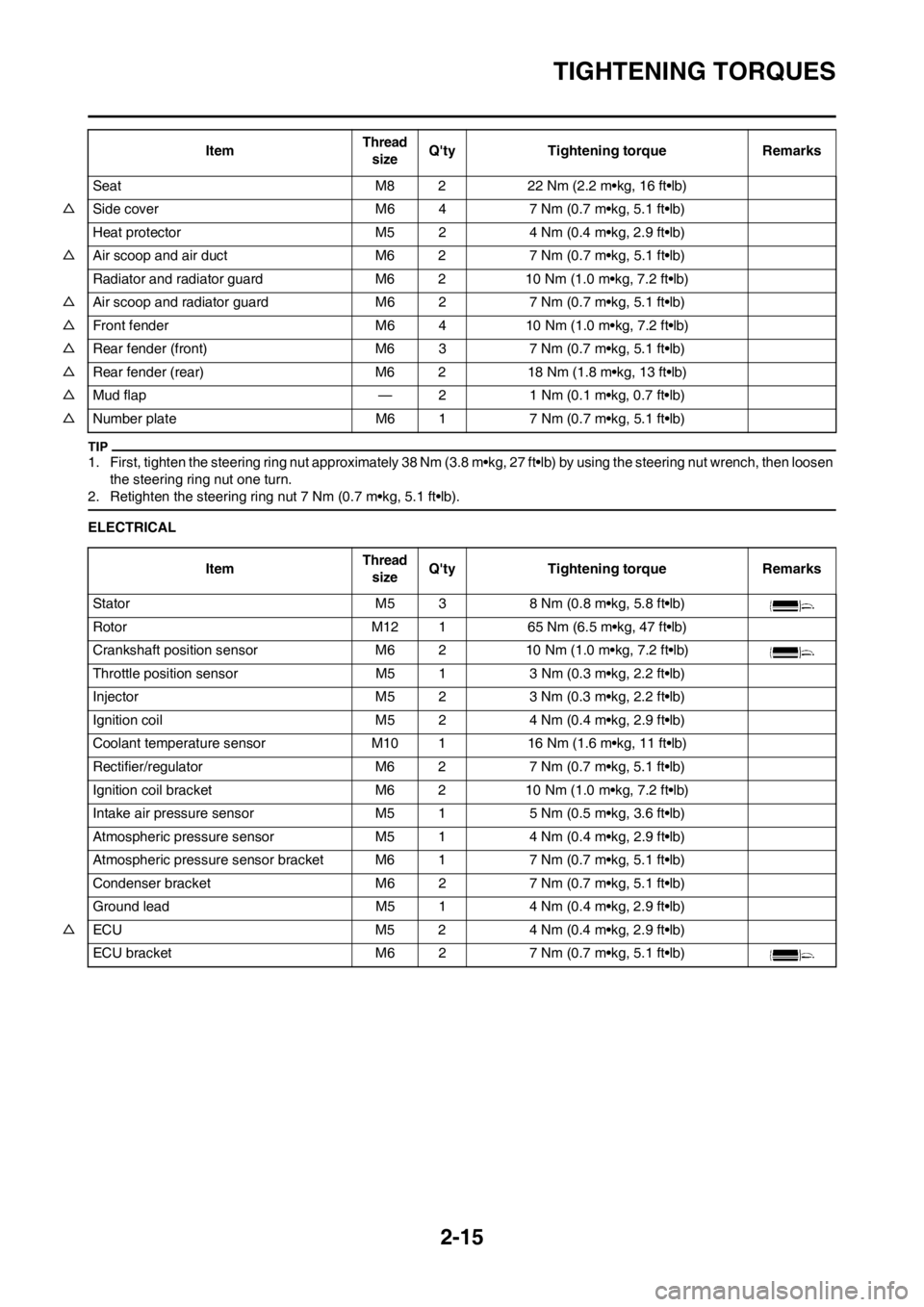
2-15
TIGHTENING TORQUES
1. First, tighten the steering ring nut approximately 38 Nm (3.8 m•kg, 27 ft•lb) by using the steering nut wrench, then loosen
the steering ring nut one turn.
2. Retighten the steering ring nut 7 Nm (0.7 m•kg, 5.1 ft•lb).
ELECTRICALSeat M8 2 22 Nm (2.2 m•kg, 16 ft•lb)
△Side cover M6 4 7 Nm (0.7 m•kg, 5.1 ft•lb)
Heat protector M5 2 4 Nm (0.4 m•kg, 2.9 ft•lb)
△Air scoop and air duct M6 2 7 Nm (0.7 m•kg, 5.1 ft•lb)
Radiator and radiator guard M6 2 10 Nm (1.0 m•kg, 7.2 ft•lb)
△Air scoop and radiator guard M6 2 7 Nm (0.7 m•kg, 5.1 ft•lb)
△Front fender M6 4 10 Nm (1.0 m•kg, 7.2 ft•lb)
△Rear fender (front) M6 3 7 Nm (0.7 m•kg, 5.1 ft•lb)
△Rear fender (rear) M6 2 18 Nm (1.8 m•kg, 13 ft•lb)
△Mud flap — 2 1 Nm (0.1 m•kg, 0.7 ft•lb)
△Number plate M6 1 7 Nm (0.7 m•kg, 5.1 ft•lb)Item
Thread
sizeQ'ty Tightening torque Remarks
ItemThread
sizeQ'ty Tightening torque Remarks
Stator M5 3 8 Nm (0.8 m•kg, 5.8 ft•lb)
Rotor M12 1 65 Nm (6.5 m•kg, 47 ft•lb)
Crankshaft position sensor M6 2 10 Nm (1.0 m•kg, 7.2 ft•lb)
Throttle position sensor M5 1 3 Nm (0.3 m•kg, 2.2 ft•lb)
Injector M5 2 3 Nm (0.3 m•kg, 2.2 ft•lb)
Ignition coil M5 2 4 Nm (0.4 m•kg, 2.9 ft•lb)
Coolant temperature sensor M10 1 16 Nm (1.6 m•kg, 11 ft•lb)
Rectifier/regulator M6 2 7 Nm (0.7 m•kg, 5.1 ft•lb)
Ignition coil bracket M6 2 10 Nm (1.0 m•kg, 7.2 ft•lb)
Intake air pressure sensor M5 1 5 Nm (0.5 m•kg, 3.6 ft•lb)
Atmospheric pressure sensor M5 1 4 Nm (0.4 m•kg, 2.9 ft•lb)
Atmospheric pressure sensor bracket M6 1 7 Nm (0.7 m•kg, 5.1 ft•lb)
Condenser bracket M6 2 7 Nm (0.7 m•kg, 5.1 ft•lb)
Ground lead M5 1 4 Nm (0.4 m•kg, 2.9 ft•lb)
△ECU M5 2 4 Nm (0.4 m•kg, 2.9 ft•lb)
ECU bracket M6 2 7 Nm (0.7 m•kg, 5.1 ft•lb)
Page 53 of 228

2-23
CABLE ROUTING DIAGRAM
1. Tension pipe
2. Coolant temperature sensor
coupler
3. Front engine bracket
4. Fuel pump coupler
5. Fuel pump
6. Intake air temperature sensor
coupler
7. Radiator hose 2
8. Radiator breather hose
9. Radiator hose 1
10. Radiator hose 4
11. Radiator pipe 2
12. Radiator hose 3
13. Cylinder head breather hose
14. Frame
15. ECU (electronic control unit)
16. ECU bracket
17. Main harness
18. AC magneto lead
19. Throttle position sensor lead
20. Condenser lead
21. Coolant temperature sensor
lead
22. Ignition coil lead
23. CondenserA. Fasten the wire harness at the
positioning tape to the ECU
bracket with a plastic locking tie.
Face the buckle of the plastic
locking tie downward, and then
cut off the excess end of the tie.
B. Install the cover onto the wire
harness coupler.
C. Route the condenser lead, throt-
tle position sensor lead, coolant
temperature sensor lead, igni-
tion coil lead, and AC magneto
lead under radiator hose 2.
D. Connect the vacuum hose to the
atmospheric pressure sensor,
and then fasten the hose with
the clamp. Make sure to face the
moving part of the sensor rear-
ward.
E. After connecting the condenser
coupler, install the coupler cover
onto the coupler.
F. After connecting the throttle po-
sition sensor coupler, install the
coupler cover onto the coupler.
G. Fasten the AC magneto lead,
condenser lead, throttle position
sensor lead, coolant tempera-
ture sensor lead, and ignition
coil lead to the frame with the
plastic band, making sure to po-
sition the band between the igni-
tion coil bracket and the tension
pipe. Face the buckle of the
plastic band to the right with the
end pointing rearward.
H. Point the end of the vacuum
hose rearward.
I. Fit the bracket into the hole in
the rubber portion of the con-
denser.
J. Fasten the radiator breather
hose to the frame with the plas-
tic band, making sure to position
the band above the front engine
bracket. Face the buckle of the
plastic band outward with the
end pointing rearward.
K. After connecting the coolant
temperature sensor coupler, in-
stall the coupler cover onto the
coupler.L. Route the radiator breather hose
between the down tubes.
M. Fasten the fuel hose and fuel
pump lead with the plastic band,
making sure to position the band
between the bend in the fuel
hose protector and the end of
the protector. Point the end of
the plastic band upward.
N. Insert the projection on the joint
coupler into the hole in the
bracket, and then install the cou-
pler cover onto the coupler.
O. Route the atmospheric pressure
sensor lead, intake air pressure
sensor lead, intake air tempera-
ture sensor lead, fuel injector
lead, and fuel pump lead above
radiator hose 2. Position the
joint coupler above radiator
hose 2.
P. Route the radiator breather hose
to the inside of radiator hose 1
and the front engine bracket.
Q. Hose installation position
(1.3–3.3 mm, 0.05–0.13 in)
R. Clip installation position (0–2.0
mm, 0–0.08 in)
S. Install the washer so that it con-
tacts the bolt head.
T. Install the collar so that the
flange on the collar contacts the
ECU bracket.
U. 6 mm (0.24 in) or less
Page 54 of 228
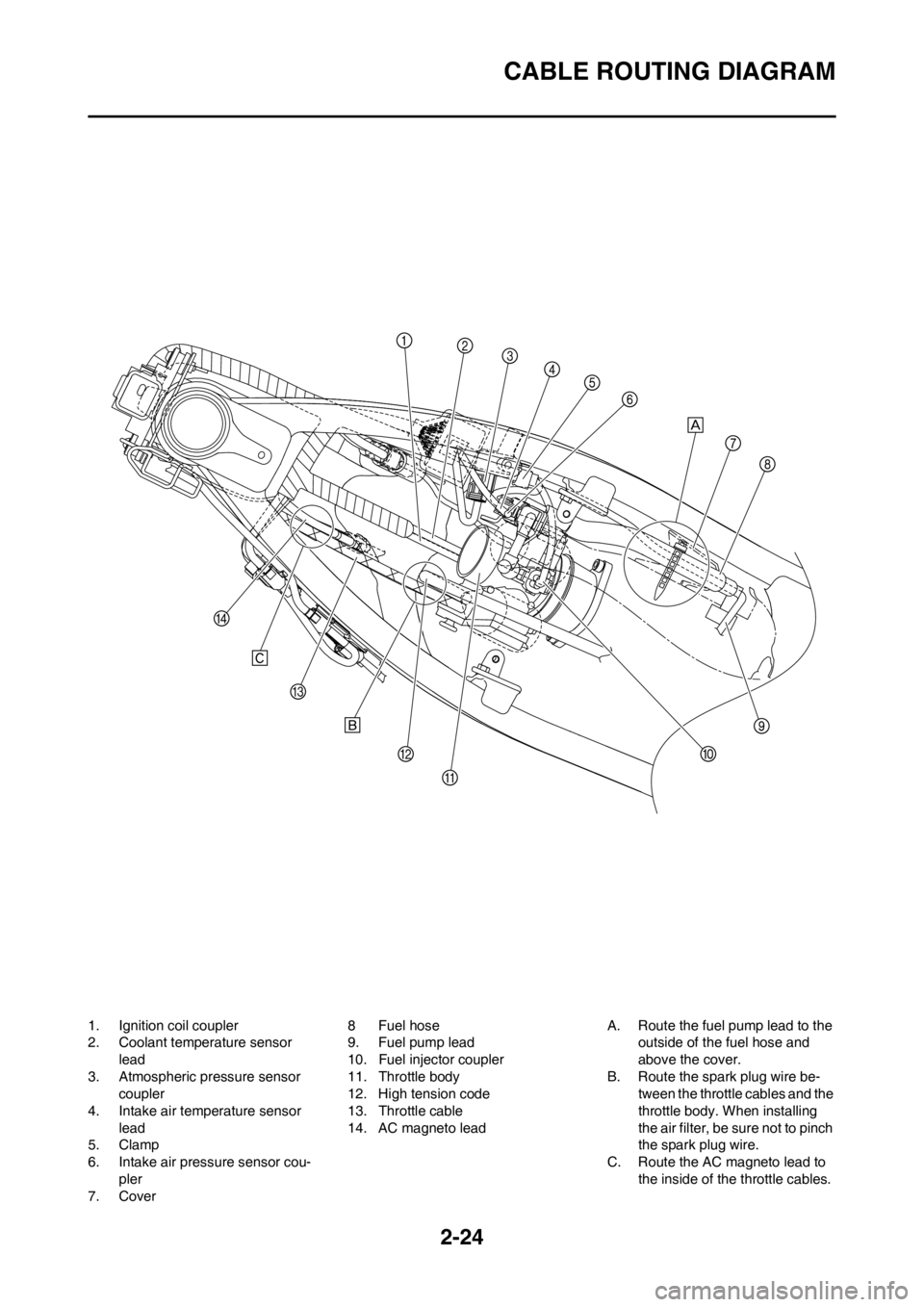
2-24
CABLE ROUTING DIAGRAM
1. Ignition coil coupler
2. Coolant temperature sensor
lead
3. Atmospheric pressure sensor
coupler
4. Intake air temperature sensor
lead
5. Clamp
6. Intake air pressure sensor cou-
pler
7. Cover8Fuel hose
9. Fuel pump lead
10. Fuel injector coupler
11. Throttle body
12. High tension code
13. Throttle cable
14. AC magneto leadA. Route the fuel pump lead to the
outside of the fuel hose and
above the cover.
B. Route the spark plug wire be-
tween the throttle cables and the
throttle body. When installing
the air filter, be sure not to pinch
the spark plug wire.
C. Route the AC magneto lead to
the inside of the throttle cables.